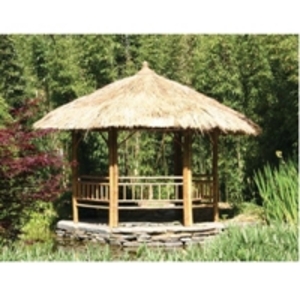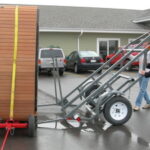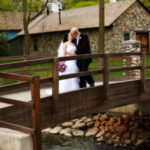Building a gazebo requires some thought in order to choose building materials that will fit your chosen location, size, weather conditions and the reason you want a gazebo in the first place. All of these things need to be considered in order to have a finished product that will last for years to come and will serve your needs for many years to come. You have to take into account what kind of Gazebo is going to fit the needs of your family. Will you be entertaining in the gazebo? Is it going to have a hot tub? How harsh are your winters? Do you encounter a lot of wind in your area? How big will it be? All of these decisions directly affect the types of materials you use to build the gazebo.
For temporary gazebos you can use lighter materials. These gazebos are usually dismantled at the end of the outdoor season. They are more often than not made from aluminum poles and fabric/screen sides and roof. They usually come altogether in a kit. Canvas is the most commonly used material for the sides and roof in these applications. Canvas is tough and will weather rain very well. These types of gazebos are great for rental property or if you don’t won’t a permanent structure in your yard.
For more permanent gazebos, sturdier materials are a better idea.
One of those materials is red cedar. This is probably the most popular material for building a gazebo. From the floor to the roof, this can be used for the entire structure with the exception of the secure base. Red Cedar is a durable wood that has many qualities that make it perfect for a gazebo. It has a wonderful aroma that stays with it forever. It naturally repels insects, doesn’t decay easily and in very environmentally friendly. You can also use almost any type of stain on it. You can buy red cedar poles, planks, shake roof supplies and decorative trim. This material can be used in most any weather conditions. Of course maintenance is required to keep it looking its best.
Another material used in building gazebos is metal such as wrought iron. This is a Victorian look that fits into many yard and garden styles. With the right garden items including vine plants, this can be very attractive. Wrought iron of course is available in many configurations. This is normally sections of a kit or pre-fab pieces that you put together with bolts or have welded on site. Wrought iron is another long lasting material to use. It will still be standing in 75 years easy. There is a drawback to using wrought iron. You will have to keep it painted. It can be painted with quality enamel paint, available at the hardware store. This will have to be done again, depending on weather conditions, humidity, etc.
Plastic can be an option. This material is great to use. It is virtually maintenance free. It should have a sturdy base, concrete or other, especially if you live in windy areas. Lightweight and long lasting. This is also a material that does not have to be painted. Usually available in white, tan or off-white, this material offers several basics styles to work with. This also can be purchased as a kit. Usually the entire structure, poles, planks, etc, are made of hardened plastics.
Another long lasting material used in building gazebos is treated pine. This is something that has been around for many years in this application. Treated pine offers most of the same options as red cedar. It is treated with a chemical that resists decay, insects and accepts most stains. It is available in poles, planks, decorative trim and frames. There are kits available but for an ambitious person this is possible to build from scratch.
Bamboo is a material that can be used in the construction of a gazebo. This to me is the most beautiful of all of the materials to use. You can build the entire frame, roof and add decorative trim made from bamboo. You can also get bamboo shades that can be raised and lowered as needed and are simple to install.
Bamboo can be painted with a sealing stain to insure it is around for years and years. This material is long lasting and durable as is, but can be beautiful and even more long lasting with proper care. This is also material that should have a solid base. It is usable in most weather conditions also.
Our last choice for frame, floor and trim materials is vinyl. This is treated pine that has been encapsulated with vinyl. This creates an extremely durable and maintenance free material to use in gazebos. This comes in kits as the others do or can be purchased and fabricated per your design as individual pieces. This does not have to be painted only washed down when needed. It does not fade, crack, decay or otherwise self destruct. This also needs that firm base.
Other materials used in the building of gazebos is the roofing materials. For the roof, you really should try and match your frame and theme.
The red cedar shake material is an excellent choice for roofing on a gazebo. This of course should be used where the style will fit the remainder of the structure.
This can be sealed and will last for many years. It is insect resistant and if applied properly, will last through fairly harsh winters.
Regular roofing material such as shingles can be used for gazebos. This is a material that has endless color choices and style choices. It is standard for this material to last 20 to 30 years minimum. Very heavy when applied so structure should be solid and secured.
Again bamboo can be used and is available in bamboo poles or slats. For gazebos in more tropical locations or milder weather you can use thatch for the roof. These of course do not last forever. They do last for several years if done properly and are again a better choice for mild weather structures.
When building a gazebo it is important to plan properly. This plan will help you pick out the materials that are going to serve you best. Gazebos are simple to build for the ambitious weekender.
The basics are:
Put in a strong base. Whether you have concrete blocks underneath your frame, spikes or you put in permanent footing and a solid slab, the base is the foundation that makes the rest of the structure long lasting and safe.
If you are going to lay flooring, this would be a good time to do that. Secure the flooring as per instructions of the design you chose. Next the frame for the rest of the gazebo will make the remainder a piece of cake to complete. Frame in the windows or doors and get the basic structure complete.
Your roof will get your gazebo close to completion. Your final task for finishing your gazebo is the trim. Trim is the crowning touch for a gazebo. Again depending on the overall design there are many types of trim that can be added.
Put in the proper location, garden placement and with proper design and materials, you can have many wonderful years of fun and pleasure with a gazebo. This is a wonderful summer project that can be done by a handyman or woman or by a professional. You can build it from scratch or buy a pre-fab kit. Either way, proper choice of materials makes the job easy.





